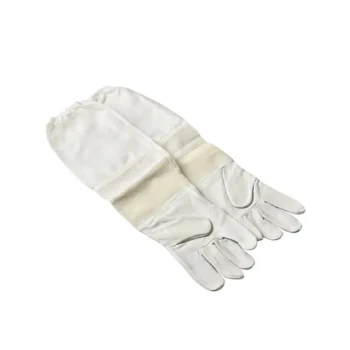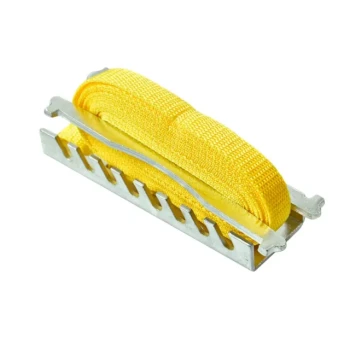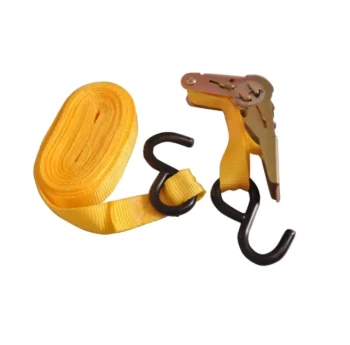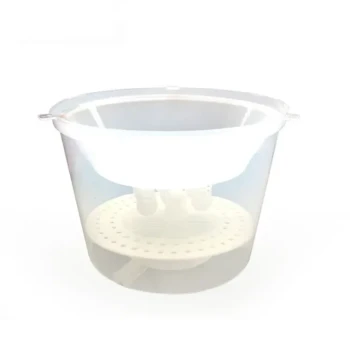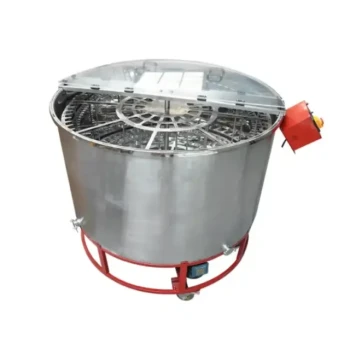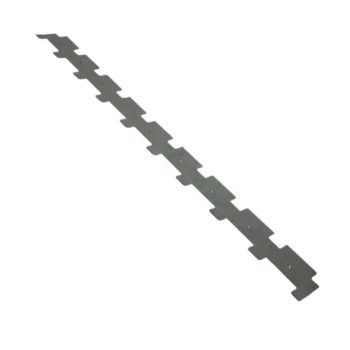To clean leather beekeeping gloves, you must wash them by hand using a specific, gentle process. Never put them in a washing machine or dryer, as this will irreparably damage the leather. The correct method involves brushing off loose debris, gently scrubbing with a mild soap solution, rinsing thoroughly, and allowing them to air dry slowly before applying a leather conditioner.
Improper cleaning will ruin your gloves, but failing to clean them risks spreading disease between your hives and shortens the equipment's lifespan. The goal is to balance hygiene with the preservation of the leather, which is achieved through gentle hand-washing and conditioning.
Why Proper Cleaning is Non-Negotiable
Before detailing the cleaning method, it's crucial to understand why this task is a core part of responsible beekeeping. It's not just about appearances.
Maintaining Hive Health
Dirty gloves can carry pathogens like bacteria, viruses, and fungal spores from one hive to another. Regular cleaning is a fundamental biosecurity practice that helps prevent the spread of disease within your apiary and to other bee yards.
Ensuring Your Safety and Usability
Gloves caked in hardened honey, wax, and propolis become stiff and difficult to use. This reduces your dexterity, making it harder to handle frames and tools, which can lead to frustrating and clumsy inspections. Clean, supple gloves provide better protection and control.
Protecting Your Investment
Leather beekeeping gloves are a significant investment. The acids in honey and the buildup of other hive products can degrade leather over time. Proper, regular cleaning followed by conditioning extends the life of your gloves, ensuring they serve you well for many seasons.
The Step-by-Step Cleaning Process
Follow these four steps to clean any type of leather beekeeping glove, whether cowhide or goatskin, without causing damage.
Step 1: Preparation and Dry Brushing
First, put the gloves on and scrape off any large deposits of wax or propolis with a hive tool. Then, use a soft-bristled brush to remove all loose surface dirt and debris. Pay special attention to the seams and areas between the fingers.
Step 2: Gentle Washing
Prepare a cleaning solution in a bucket using warm water and a mild soap, such as a dedicated leather cleaner or a small amount of gentle laundry detergent. Do not use harsh household cleaners or bleach.
Dip a soft cloth or brush into the soapy water, wring it out, and gently scrub the surface of the gloves. Focus on heavily soiled areas, but avoid completely soaking the leather through.
Step 3: Rinsing and Drying
Once the gloves are clean, use a separate clean, damp cloth to wipe away all soap residue. Alternatively, you can rinse them briefly under cool, running water.
Gently squeeze out any excess water from the fingers toward the cuff, but do not twist or wring the gloves. Pat them dry with a towel and hang them to air dry in a shaded, well-ventilated area. Never place them in direct sunlight or near a heat source, as this will cause the leather to shrink and crack.
Step 4: Conditioning the Leather
This final step is critical for restoring the leather's natural oils and keeping it supple. Once the gloves are completely dry, apply a small amount of a quality leather conditioner.
Work the conditioner into the leather with a clean cloth. The gloves will feel softer and more flexible, restoring their protective qualities.
Common Pitfalls to Avoid
Mistakes during cleaning can cause more harm than the dirt itself. Be mindful of these common errors.
Never Use a Washing Machine or Dryer
The combination of intense water saturation, agitation, and high heat will permanently shrink, stiffen, and crack the leather, rendering your gloves useless.
Avoid Harsh Chemicals and Soaps
Strong detergents, bleach, and general-purpose household cleaners will strip the essential oils from the leather, causing it to become dry and brittle. They can also leave behind scents that may agitate your bees.
Handling Different Leather Types
While the overall process is the same, cowhide and goatskin have slight differences. Goatskin is more porous and absorbs oils easily, so use conditioner sparingly. For stubborn stains, you can test a small paste of baking soda and water on goatskin or a bit of white vinegar on cowhide, always on an inconspicuous area first.
Applying This to Your Beekeeping Practice
Use these guidelines to integrate glove cleaning into your regular hive maintenance routine.
- If your primary focus is maximum hive hygiene: Clean your gloves after every few inspections, and always clean them after visiting another beekeeper's apiary to prevent cross-contamination.
- If your primary focus is glove longevity: Never skip the conditioning step after washing, as this is what keeps the leather from becoming brittle and extends its usable life.
- If you are dealing with heavy propolis buildup: Scrape off the sticky residue with your hive tool while it's fresh, as it becomes much harder to remove once it has fully hardened.
Properly maintained gloves are not just a tool, but a reliable partner in responsible and effective beekeeping.
Summary Table:
| Step | Key Action | Purpose |
|---|---|---|
| 1. Preparation | Dry brush to remove debris | Prevents scratching during wash |
| 2. Washing | Use mild soap and warm water | Cleans gently without damaging leather |
| 3. Drying | Air dry away from heat/sun | Prevents shrinking and cracking |
| 4. Conditioning | Apply leather conditioner | Restores suppleness and protection |
Keep your apiary running smoothly with reliable, durable equipment from HONESTBEE. We supply commercial apiaries and beekeeping equipment distributors with the high-quality wholesale supplies needed for success. From gloves to full suits, our gear is built to withstand the rigors of professional beekeeping. Let us help you protect your investment and your hives. Contact our wholesale team today to discuss your equipment needs.
Visual Guide

Related Products
- Goat Skin Leather Bee Sting Proof Beekeeping Gloves with Canvas Sleeve
- Goatskin Leather Beekeeper Gloves with Vent Long Sleeve for Beekeeping Honey Bee Sting Proof Protection
- Mesh Ventilated 3 Layer Goatskin Beekeepers Gloves for Beekeeping
- Professional Beekeeping Suit for Kids and Girls Childrens Bee Keeper Suit
- Professional Galvanized Hive Strap with Secure Locking Buckle for Beekeeping
People Also Ask
- What types of gloves are commonly used by beekeepers? A Guide to Leather, Goatskin & Nitrile
- What should beginner beekeepers consider when choosing beekeeping gloves? Balance Protection and Dexterity for Success
- What are the key features to look for in beekeeping gloves? Find the Perfect Balance of Protection & Dexterity
- What types of gloves are most effective at preventing bee stings? Durable Goatskin & Nitrile Barriers
- What are the steps to clean goat leather beekeeping gloves? A Guide to Extend Gear Life

